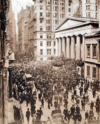Wikipedia:Today's featured article/October 23, 2008
The Panic of 1907 was a financial crisis that occurred in the United States when its stock market fell close to 50 percent from its peak the previous year. Primary causes of the run included a retraction of market liquidity by a number of New York City banks, a loss of confidence among depositors, and the absence of a statutory lender of last resort. The crisis occurred after the failure of an attempt in October 1907 to corner the market on stock of the United Copper Company. When this bid failed, banks that had lent money to the cornering scheme suffered runs which later spread to affiliated banks and trusts, leading a week later to the downfall of the Knickerbocker Trust Company—New York City's third-largest trust. The collapse of the Knickerbocker spread fear throughout the city's trusts as regional banks withdrew reserves from New York City banks. The panic would have deepened if not for the intervention of financier J.P. Morgan, who pledged large sums of his own money, and convinced other New York bankers to do the same, to shore up the banking system. By November the contagion had largely ended. The following year, Senator Nelson W. Aldrich established and chaired a commission to investigate the crisis and propose future solutions, leading to the creation of the Federal Reserve System. (more...)
Recently featured: 1995 Pacific Grand Prix – Natalee Holloway – History of Baltimore City College

